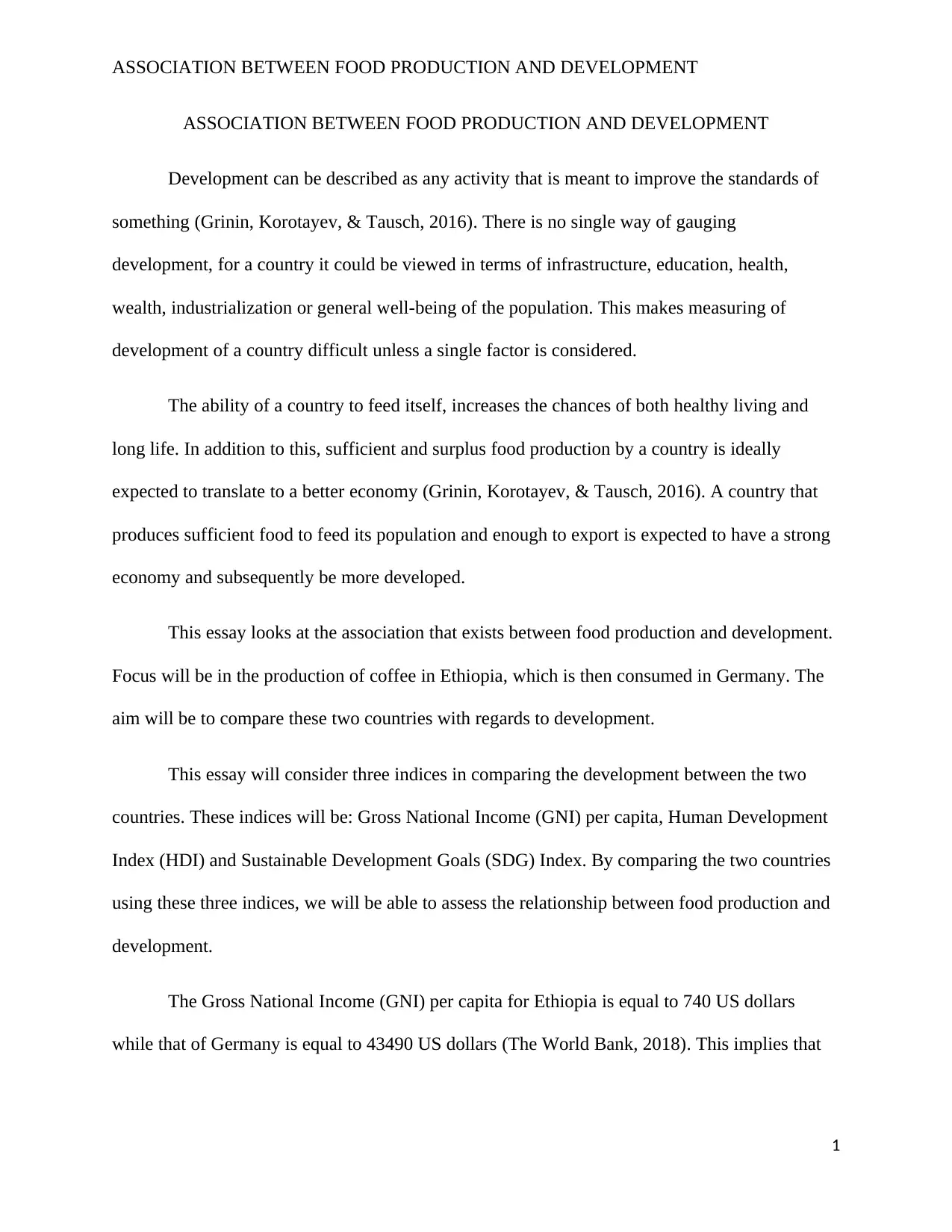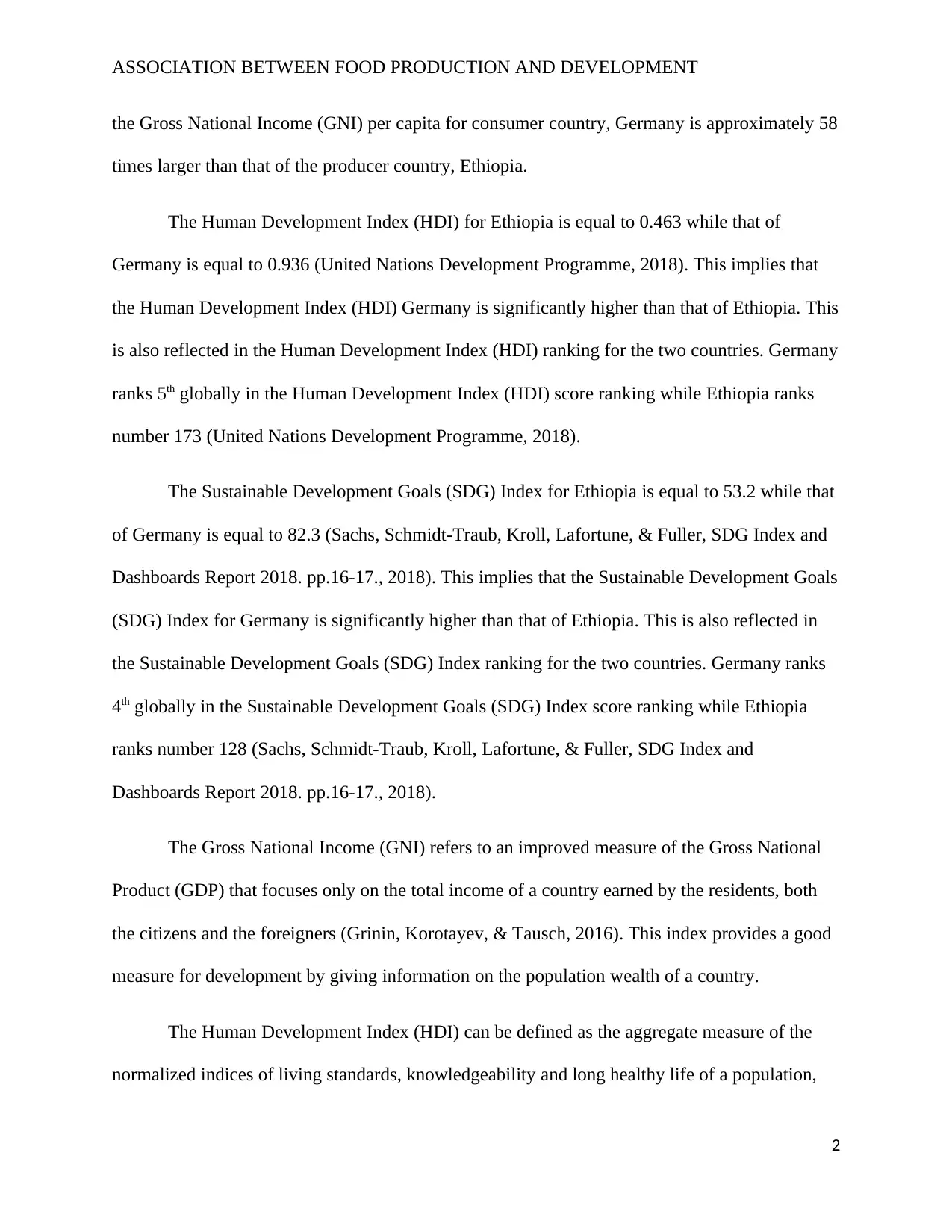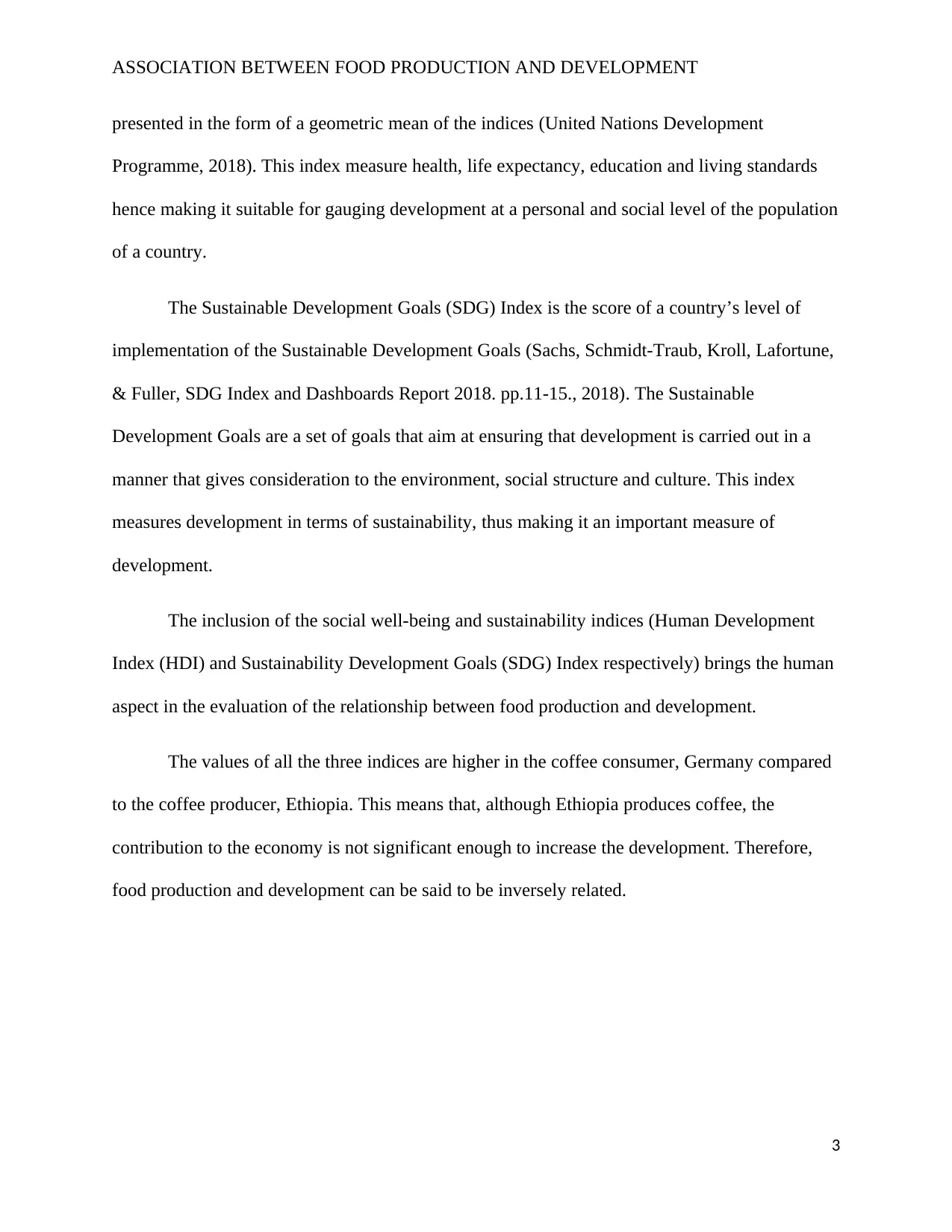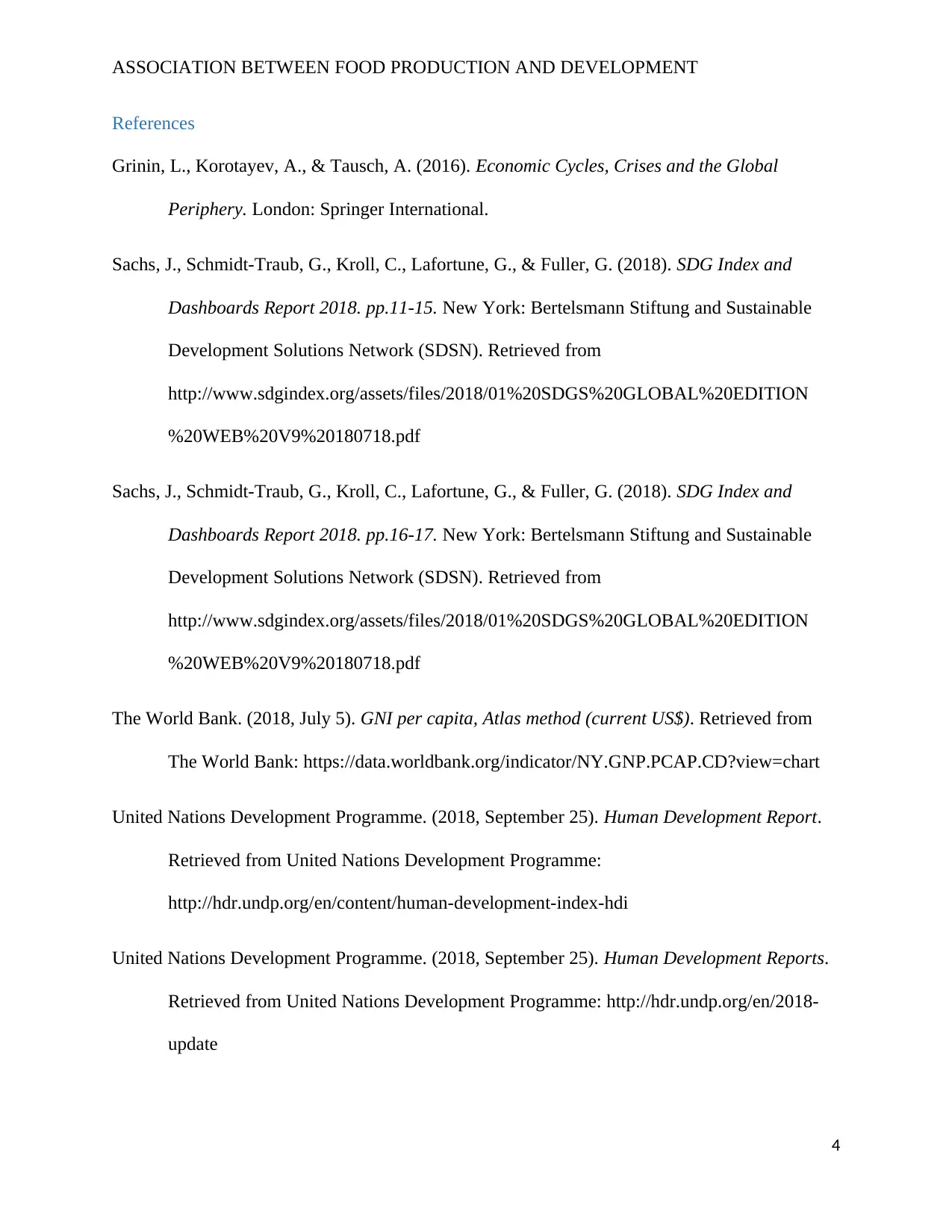An Analysis of the Association Between Food Production and Development
VerifiedAdded on 2023/04/22
|4
|1196
|307
Essay
AI Summary
This essay examines the association between food production and development by comparing Ethiopia, a coffee producer, and Germany, a consumer, using Gross National Income (GNI) per capita, Human Development Index (HDI), and Sustainable Development Goals (SDG) Index. The analysis reveals that Germany, the consumer country, has significantly higher values in all three indices compared to Ethiopia. This suggests an inverse relationship between food production and development in this context, indicating that simply producing food, like coffee, does not guarantee significant economic advancement or overall development for the producing nation. Desklib offers this essay and many more resources for students.

ASSOCIATION BETWEEN FOOD PRODUCTION AND DEVELOPMENT
ASSOCIATION BETWEEN FOOD PRODUCTION AND DEVELOPMENT
Development can be described as any activity that is meant to improve the standards of
something (Grinin, Korotayev, & Tausch, 2016). There is no single way of gauging
development, for a country it could be viewed in terms of infrastructure, education, health,
wealth, industrialization or general well-being of the population. This makes measuring of
development of a country difficult unless a single factor is considered.
The ability of a country to feed itself, increases the chances of both healthy living and
long life. In addition to this, sufficient and surplus food production by a country is ideally
expected to translate to a better economy (Grinin, Korotayev, & Tausch, 2016). A country that
produces sufficient food to feed its population and enough to export is expected to have a strong
economy and subsequently be more developed.
This essay looks at the association that exists between food production and development.
Focus will be in the production of coffee in Ethiopia, which is then consumed in Germany. The
aim will be to compare these two countries with regards to development.
This essay will consider three indices in comparing the development between the two
countries. These indices will be: Gross National Income (GNI) per capita, Human Development
Index (HDI) and Sustainable Development Goals (SDG) Index. By comparing the two countries
using these three indices, we will be able to assess the relationship between food production and
development.
The Gross National Income (GNI) per capita for Ethiopia is equal to 740 US dollars
while that of Germany is equal to 43490 US dollars (The World Bank, 2018). This implies that
1
ASSOCIATION BETWEEN FOOD PRODUCTION AND DEVELOPMENT
Development can be described as any activity that is meant to improve the standards of
something (Grinin, Korotayev, & Tausch, 2016). There is no single way of gauging
development, for a country it could be viewed in terms of infrastructure, education, health,
wealth, industrialization or general well-being of the population. This makes measuring of
development of a country difficult unless a single factor is considered.
The ability of a country to feed itself, increases the chances of both healthy living and
long life. In addition to this, sufficient and surplus food production by a country is ideally
expected to translate to a better economy (Grinin, Korotayev, & Tausch, 2016). A country that
produces sufficient food to feed its population and enough to export is expected to have a strong
economy and subsequently be more developed.
This essay looks at the association that exists between food production and development.
Focus will be in the production of coffee in Ethiopia, which is then consumed in Germany. The
aim will be to compare these two countries with regards to development.
This essay will consider three indices in comparing the development between the two
countries. These indices will be: Gross National Income (GNI) per capita, Human Development
Index (HDI) and Sustainable Development Goals (SDG) Index. By comparing the two countries
using these three indices, we will be able to assess the relationship between food production and
development.
The Gross National Income (GNI) per capita for Ethiopia is equal to 740 US dollars
while that of Germany is equal to 43490 US dollars (The World Bank, 2018). This implies that
1
Paraphrase This Document
Need a fresh take? Get an instant paraphrase of this document with our AI Paraphraser

ASSOCIATION BETWEEN FOOD PRODUCTION AND DEVELOPMENT
the Gross National Income (GNI) per capita for consumer country, Germany is approximately 58
times larger than that of the producer country, Ethiopia.
The Human Development Index (HDI) for Ethiopia is equal to 0.463 while that of
Germany is equal to 0.936 (United Nations Development Programme, 2018). This implies that
the Human Development Index (HDI) Germany is significantly higher than that of Ethiopia. This
is also reflected in the Human Development Index (HDI) ranking for the two countries. Germany
ranks 5th globally in the Human Development Index (HDI) score ranking while Ethiopia ranks
number 173 (United Nations Development Programme, 2018).
The Sustainable Development Goals (SDG) Index for Ethiopia is equal to 53.2 while that
of Germany is equal to 82.3 (Sachs, Schmidt-Traub, Kroll, Lafortune, & Fuller, SDG Index and
Dashboards Report 2018. pp.16-17., 2018). This implies that the Sustainable Development Goals
(SDG) Index for Germany is significantly higher than that of Ethiopia. This is also reflected in
the Sustainable Development Goals (SDG) Index ranking for the two countries. Germany ranks
4th globally in the Sustainable Development Goals (SDG) Index score ranking while Ethiopia
ranks number 128 (Sachs, Schmidt-Traub, Kroll, Lafortune, & Fuller, SDG Index and
Dashboards Report 2018. pp.16-17., 2018).
The Gross National Income (GNI) refers to an improved measure of the Gross National
Product (GDP) that focuses only on the total income of a country earned by the residents, both
the citizens and the foreigners (Grinin, Korotayev, & Tausch, 2016). This index provides a good
measure for development by giving information on the population wealth of a country.
The Human Development Index (HDI) can be defined as the aggregate measure of the
normalized indices of living standards, knowledgeability and long healthy life of a population,
2
the Gross National Income (GNI) per capita for consumer country, Germany is approximately 58
times larger than that of the producer country, Ethiopia.
The Human Development Index (HDI) for Ethiopia is equal to 0.463 while that of
Germany is equal to 0.936 (United Nations Development Programme, 2018). This implies that
the Human Development Index (HDI) Germany is significantly higher than that of Ethiopia. This
is also reflected in the Human Development Index (HDI) ranking for the two countries. Germany
ranks 5th globally in the Human Development Index (HDI) score ranking while Ethiopia ranks
number 173 (United Nations Development Programme, 2018).
The Sustainable Development Goals (SDG) Index for Ethiopia is equal to 53.2 while that
of Germany is equal to 82.3 (Sachs, Schmidt-Traub, Kroll, Lafortune, & Fuller, SDG Index and
Dashboards Report 2018. pp.16-17., 2018). This implies that the Sustainable Development Goals
(SDG) Index for Germany is significantly higher than that of Ethiopia. This is also reflected in
the Sustainable Development Goals (SDG) Index ranking for the two countries. Germany ranks
4th globally in the Sustainable Development Goals (SDG) Index score ranking while Ethiopia
ranks number 128 (Sachs, Schmidt-Traub, Kroll, Lafortune, & Fuller, SDG Index and
Dashboards Report 2018. pp.16-17., 2018).
The Gross National Income (GNI) refers to an improved measure of the Gross National
Product (GDP) that focuses only on the total income of a country earned by the residents, both
the citizens and the foreigners (Grinin, Korotayev, & Tausch, 2016). This index provides a good
measure for development by giving information on the population wealth of a country.
The Human Development Index (HDI) can be defined as the aggregate measure of the
normalized indices of living standards, knowledgeability and long healthy life of a population,
2

ASSOCIATION BETWEEN FOOD PRODUCTION AND DEVELOPMENT
presented in the form of a geometric mean of the indices (United Nations Development
Programme, 2018). This index measure health, life expectancy, education and living standards
hence making it suitable for gauging development at a personal and social level of the population
of a country.
The Sustainable Development Goals (SDG) Index is the score of a country’s level of
implementation of the Sustainable Development Goals (Sachs, Schmidt-Traub, Kroll, Lafortune,
& Fuller, SDG Index and Dashboards Report 2018. pp.11-15., 2018). The Sustainable
Development Goals are a set of goals that aim at ensuring that development is carried out in a
manner that gives consideration to the environment, social structure and culture. This index
measures development in terms of sustainability, thus making it an important measure of
development.
The inclusion of the social well-being and sustainability indices (Human Development
Index (HDI) and Sustainability Development Goals (SDG) Index respectively) brings the human
aspect in the evaluation of the relationship between food production and development.
The values of all the three indices are higher in the coffee consumer, Germany compared
to the coffee producer, Ethiopia. This means that, although Ethiopia produces coffee, the
contribution to the economy is not significant enough to increase the development. Therefore,
food production and development can be said to be inversely related.
3
presented in the form of a geometric mean of the indices (United Nations Development
Programme, 2018). This index measure health, life expectancy, education and living standards
hence making it suitable for gauging development at a personal and social level of the population
of a country.
The Sustainable Development Goals (SDG) Index is the score of a country’s level of
implementation of the Sustainable Development Goals (Sachs, Schmidt-Traub, Kroll, Lafortune,
& Fuller, SDG Index and Dashboards Report 2018. pp.11-15., 2018). The Sustainable
Development Goals are a set of goals that aim at ensuring that development is carried out in a
manner that gives consideration to the environment, social structure and culture. This index
measures development in terms of sustainability, thus making it an important measure of
development.
The inclusion of the social well-being and sustainability indices (Human Development
Index (HDI) and Sustainability Development Goals (SDG) Index respectively) brings the human
aspect in the evaluation of the relationship between food production and development.
The values of all the three indices are higher in the coffee consumer, Germany compared
to the coffee producer, Ethiopia. This means that, although Ethiopia produces coffee, the
contribution to the economy is not significant enough to increase the development. Therefore,
food production and development can be said to be inversely related.
3
⊘ This is a preview!⊘
Do you want full access?
Subscribe today to unlock all pages.

Trusted by 1+ million students worldwide

ASSOCIATION BETWEEN FOOD PRODUCTION AND DEVELOPMENT
References
Grinin, L., Korotayev, A., & Tausch, A. (2016). Economic Cycles, Crises and the Global
Periphery. London: Springer International.
Sachs, J., Schmidt-Traub, G., Kroll, C., Lafortune, G., & Fuller, G. (2018). SDG Index and
Dashboards Report 2018. pp.11-15. New York: Bertelsmann Stiftung and Sustainable
Development Solutions Network (SDSN). Retrieved from
http://www.sdgindex.org/assets/files/2018/01%20SDGS%20GLOBAL%20EDITION
%20WEB%20V9%20180718.pdf
Sachs, J., Schmidt-Traub, G., Kroll, C., Lafortune, G., & Fuller, G. (2018). SDG Index and
Dashboards Report 2018. pp.16-17. New York: Bertelsmann Stiftung and Sustainable
Development Solutions Network (SDSN). Retrieved from
http://www.sdgindex.org/assets/files/2018/01%20SDGS%20GLOBAL%20EDITION
%20WEB%20V9%20180718.pdf
The World Bank. (2018, July 5). GNI per capita, Atlas method (current US$). Retrieved from
The World Bank: https://data.worldbank.org/indicator/NY.GNP.PCAP.CD?view=chart
United Nations Development Programme. (2018, September 25). Human Development Report.
Retrieved from United Nations Development Programme:
http://hdr.undp.org/en/content/human-development-index-hdi
United Nations Development Programme. (2018, September 25). Human Development Reports.
Retrieved from United Nations Development Programme: http://hdr.undp.org/en/2018-
update
4
References
Grinin, L., Korotayev, A., & Tausch, A. (2016). Economic Cycles, Crises and the Global
Periphery. London: Springer International.
Sachs, J., Schmidt-Traub, G., Kroll, C., Lafortune, G., & Fuller, G. (2018). SDG Index and
Dashboards Report 2018. pp.11-15. New York: Bertelsmann Stiftung and Sustainable
Development Solutions Network (SDSN). Retrieved from
http://www.sdgindex.org/assets/files/2018/01%20SDGS%20GLOBAL%20EDITION
%20WEB%20V9%20180718.pdf
Sachs, J., Schmidt-Traub, G., Kroll, C., Lafortune, G., & Fuller, G. (2018). SDG Index and
Dashboards Report 2018. pp.16-17. New York: Bertelsmann Stiftung and Sustainable
Development Solutions Network (SDSN). Retrieved from
http://www.sdgindex.org/assets/files/2018/01%20SDGS%20GLOBAL%20EDITION
%20WEB%20V9%20180718.pdf
The World Bank. (2018, July 5). GNI per capita, Atlas method (current US$). Retrieved from
The World Bank: https://data.worldbank.org/indicator/NY.GNP.PCAP.CD?view=chart
United Nations Development Programme. (2018, September 25). Human Development Report.
Retrieved from United Nations Development Programme:
http://hdr.undp.org/en/content/human-development-index-hdi
United Nations Development Programme. (2018, September 25). Human Development Reports.
Retrieved from United Nations Development Programme: http://hdr.undp.org/en/2018-
update
4
1 out of 4
Your All-in-One AI-Powered Toolkit for Academic Success.
+13062052269
info@desklib.com
Available 24*7 on WhatsApp / Email
![[object Object]](/_next/static/media/star-bottom.7253800d.svg)
Unlock your academic potential
Copyright © 2020–2025 A2Z Services. All Rights Reserved. Developed and managed by ZUCOL.